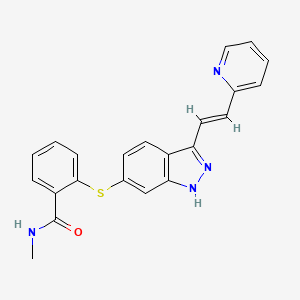



1. Ag 013736
2. Ag-013736
3. Ag013736
4. Inlyta
1. 319460-85-0
2. Ag-013736
3. Inlyta
4. Ag 013736
5. (e)-n-methyl-2-((3-(2-(pyridin-2-yl)vinyl)-1h-indazol-6-yl)thio)benzamide
6. Ag-13736
7. Ag013736
8. C9lvq0yuxg
9. N-methyl-2-((3-((1e)-2-(pyridin-2-yl)ethenyl)-1h-indazol-6-yl)sulfanyl)benzamide
10. Nsc-757441
11. Chebi:66910
12. (e)-n-methyl-2-(3-(2-(pyridin-2-yl)vinyl)-1h-indazol-6-ylthio)benzamide
13. N-methyl-2-[[3-[(e)-2-pyridin-2-ylethenyl]-1h-indazol-6-yl]sulfanyl]benzamide
14. Nsc757441
15. N-methyl-2-({3-[(e)-2-(pyridin-2-yl)ethenyl]-1h-indazol-6-yl}sulfanyl)benzamide
16. Ncgc00241108-01
17. S1005
18. Dsstox_cid_28975
19. Dsstox_rid_83240
20. Dsstox_gsid_49049
21. Axitinib (ag 013736)
22. N-methyl-2-({3-[(e)-2-(pyridin-2-yl)vinyl]-1h-indazol-6-yl}sulfanyl)benzamide
23. N-methyl-2-(3-((e)-2-pyridin-2-yl-vinyl)-1h-indazol-6-ylsulfanyl)-benzamide
24. Axitinib [usan]
25. Cas-319460-85-0
26. Unii-c9lvq0yuxg
27. Axitinibum
28. Axitinib [usan:inn:jan]
29. 4agc
30. Benzamide, N-methyl-2-((3-((1e)-2-(2-pyridinyl)ethenyl)-1h-indazol-6-yl)thio)-
31. Benzamide, N-methyl-2-[[3-[(1e)-2-(2-pyridinyl)ethenyl]-1h-indazol-6-yl]thio]-
32. Inlyta (tn)
33. Mfcd09837898
34. Ag13736
35. 4ag8
36. Axitinib (jan/usan)
37. Axitinib [inn]
38. Axitinib [jan]
39. Axitinib [mi]
40. Axitinib [vandf]
41. Axitinib [mart.]
42. Ag-013736;axitinib
43. Axitinib [who-dd]
44. Axitinib,ag-013736
45. Mls006010164
46. Schembl172918
47. Axitinib [orange Book]
48. Gtpl5659
49. Axitinib, >=98% (hplc)
50. Chembl1289926
51. Dtxsid3049049
52. N-methyl-2-[[3-[2-(2-pyridinyl)ethenyl]-1h-indazol-6-yl]thio]benzamide
53. Schembl22930506
54. Bdbm25117
55. Chebi:94568
56. Ex-a337
57. Bcpp000372
58. Bcp01371
59. Zinc3816287
60. Tox21_113597
61. Nsc799341
62. Akos015902898
63. Tox21_113597_1
64. Ac-1539
65. Bcp9000345
66. Ccg-264772
67. Cs-0116
68. Db06626
69. Ks-1448
70. Nsc 757441
71. Nsc-799341
72. Benzamide, N-methyl-2-((3-((e)-2-(2-pyridinyl)ethenyl)-1h-indazol-6-yl)thio)-
73. Ncgc00241108-04
74. Ncgc00241108-06
75. Hy-10065
76. Smr002530046
77. Am20090673
78. Sw219464-1
79. D03218
80. Ab01274739-01
81. Ab01274739_02
82. 460a850
83. Sr-01000941566
84. J-502064
85. Q-200662
86. Q4830631
87. Sr-01000941566-1
88. Brd-k29905972-001-01-4
89. Brd-k29905972-001-02-2
90. Benzamide, N-methyl-2-((3-((1e)-2-(2-pyridinyl)ethenyl)-1h-indazo)-6-yl)thio)-
91. N-methyl-[[3[(1e)-2-(2-pyridinyl)ethenyl]-1h-indazol-6-yl]thio]-benzamide
92. N-methyl-2((3-((1e0-2-(pyridin-2-yl)ethenyl)-1h-inazol-6-ylsufanyl)benzamide
93. N-methyl-2-({3-[(e)-2-pyridin-2-ylethenyl]-2h-indazol-6-yl}sulfanyl)benzamide
| Molecular Weight | 386.5 g/mol |
|---|---|
| Molecular Formula | C22H18N4OS |
| XLogP3 | 4.2 |
| Hydrogen Bond Donor Count | 2 |
| Hydrogen Bond Acceptor Count | 4 |
| Rotatable Bond Count | 5 |
| Exact Mass | 386.12013238 g/mol |
| Monoisotopic Mass | 386.12013238 g/mol |
| Topological Polar Surface Area | 96 Ų |
| Heavy Atom Count | 28 |
| Formal Charge | 0 |
| Complexity | 557 |
| Isotope Atom Count | 0 |
| Defined Atom Stereocenter Count | 0 |
| Undefined Atom Stereocenter Count | 0 |
| Defined Bond Stereocenter Count | 1 |
| Undefined Bond Stereocenter Count | 0 |
| Covalently Bonded Unit Count | 1 |
| 1 of 2 | |
|---|---|
| Drug Name | Inlyta |
| PubMed Health | Axitinib (By mouth) |
| Drug Classes | Antineoplastic Agent |
| Drug Label | INLYTA (axitinib) is a kinase inhibitor. Axitinib has the chemical name N-methyl-2-[3-((E)-2-pyridin-2-yl-vinyl)-1H-indazol-6-ylsulfanyl]-benzamide. The molecular formula is C22H18N4OS and the molecular weight is 386.47 Daltons. The chemical structur... |
| Active Ingredient | Axitinib |
| Dosage Form | Tablet |
| Route | Oral |
| Strength | 1mg; 5mg |
| Market Status | Prescription |
| Company | Pfizer |
| 2 of 2 | |
|---|---|
| Drug Name | Inlyta |
| PubMed Health | Axitinib (By mouth) |
| Drug Classes | Antineoplastic Agent |
| Drug Label | INLYTA (axitinib) is a kinase inhibitor. Axitinib has the chemical name N-methyl-2-[3-((E)-2-pyridin-2-yl-vinyl)-1H-indazol-6-ylsulfanyl]-benzamide. The molecular formula is C22H18N4OS and the molecular weight is 386.47 Daltons. The chemical structur... |
| Active Ingredient | Axitinib |
| Dosage Form | Tablet |
| Route | Oral |
| Strength | 1mg; 5mg |
| Market Status | Prescription |
| Company | Pfizer |
Used in kidney cell cancer and investigated for use/treatment in pancreatic and thyroid cancer.
FDA Label
Inlyta is indicated for the treatment of adult patients with advanced renal cell carcinoma (RCC) after failure of prior treatment with sunitinib or a cytokine.
Axitinib prevents the progression of cancer by inhibiting angiogenesis and blocking tumor growth.
Antineoplastic Agents
Substances that inhibit or prevent the proliferation of NEOPLASMS. (See all compounds classified as Antineoplastic Agents.)
Protein Kinase Inhibitors
Agents that inhibit PROTEIN KINASES. (See all compounds classified as Protein Kinase Inhibitors.)
L01EK01
L01XE17
S76 | LUXPHARMA | Pharmaceuticals Marketed in Luxembourg | Pharmaceuticals marketed in Luxembourg, as published by d'Gesondheetskeess (CNS, la caisse nationale de sante, www.cns.lu), mapped by name to structures using CompTox by R. Singh et al. (in prep.). List downloaded from https://cns.public.lu/en/legislations/textes-coordonnes/liste-med-comm.html. Dataset DOI:10.5281/zenodo.4587355
L - Antineoplastic and immunomodulating agents
L01 - Antineoplastic agents
L01E - Protein kinase inhibitors
L01EK - Vascular endothelial growth factor receptor (vegfr) tyrosine kinase inhibitors
L01EK01 - Axitinib
Absorption
After one 5 mg dose of axitinib, it takes about 2.5 to 4.1 hours to reach maximum plasma concentration.
Route of Elimination
Axitinib is mainly eliminated unchanged in the feces (41%) with 12% of the original dose as unchanged axitinib. There is also 23% eliminated in the urine, most of which are metabolites.
Volume of Distribution
The volume of distribution is 160 L.
Clearance
The average clearance of axitinib is 38 L/h.
Axitinib undergoes mainly hepatic metabolism. CYP3A4 and CYP3A5 are the main hepatic enzymes while CYP1A2, CYP2C19, and UGT1A1 enzymes are secondary.
Axitinib has a half life of 2.5 to 6.1 hours.
Axitinib selectively blocks the tyrosine kinase receptors VEGFR-1 (vascular endothelial growth factor receptor), VEGFR-2, and VEGFR-3.